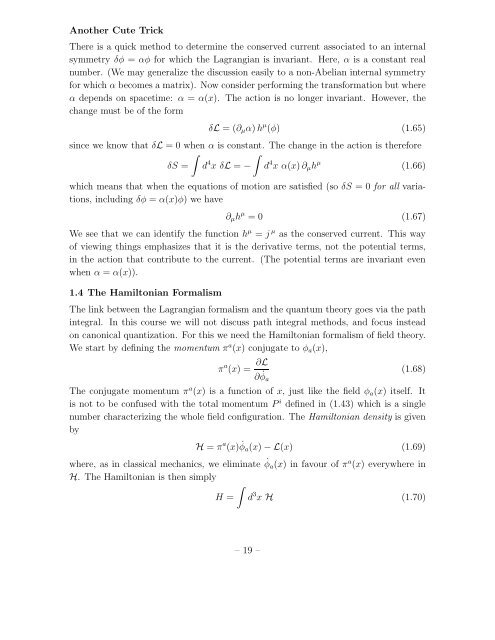Quantum Field Theory
Quantum Field Theory
Quantum Field Theory
Create successful ePaper yourself
Turn your PDF publications into a flip-book with our unique Google optimized e-Paper software.
Another Cute TrickThere is a quick method to determine the conserved current associated to an internalsymmetry δφ = αφ for which the Lagrangian is invariant. Here, α is a constant realnumber. (We may generalize the discussion easily to a non-Abelian internal symmetryfor which α becomes a matrix). Now consider performing the transformation but whereα depends on spacetime: α = α(x). The action is no longer invariant. However, thechange must be of the formδL = (∂ µ α) h µ (φ) (1.65)since we know that δL = 0 when α is constant. The change in the action is therefore∫ ∫δS = d 4 x δL = − d 4 x α(x) ∂ µ h µ (1.66)which means that when the equations of motion are satisfied (so δS = 0 for all variations,including δφ = α(x)φ) we have∂ µ h µ = 0 (1.67)We see that we can identify the function h µ = j µ as the conserved current. This wayof viewing things emphasizes that it is the derivative terms, not the potential terms,in the action that contribute to the current. (The potential terms are invariant evenwhen α = α(x)).1.4 The Hamiltonian FormalismThe link between the Lagrangian formalism and the quantum theory goes via the pathintegral. In this course we will not discuss path integral methods, and focus insteadon canonical quantization. For this we need the Hamiltonian formalism of field theory.We start by defining the momentum π a (x) conjugate to φ a (x),π a (x) = ∂L∂ ˙φ a(1.68)The conjugate momentum π a (x) is a function of x, just like the field φ a (x) itself. Itis not to be confused with the total momentum P i defined in (1.43) which is a singlenumber characterizing the whole field configuration. The Hamiltonian density is givenbyH = π a (x) ˙φ a (x) − L(x) (1.69)where, as in classical mechanics, we eliminate ˙φ a (x) in favour of π a (x) everywhere inH. The Hamiltonian is then simply∫H = d 3 x H (1.70)– 19 –
















